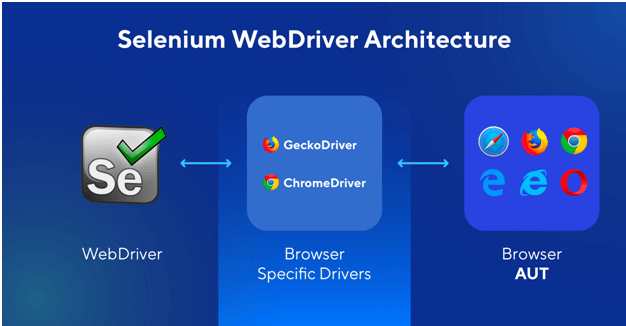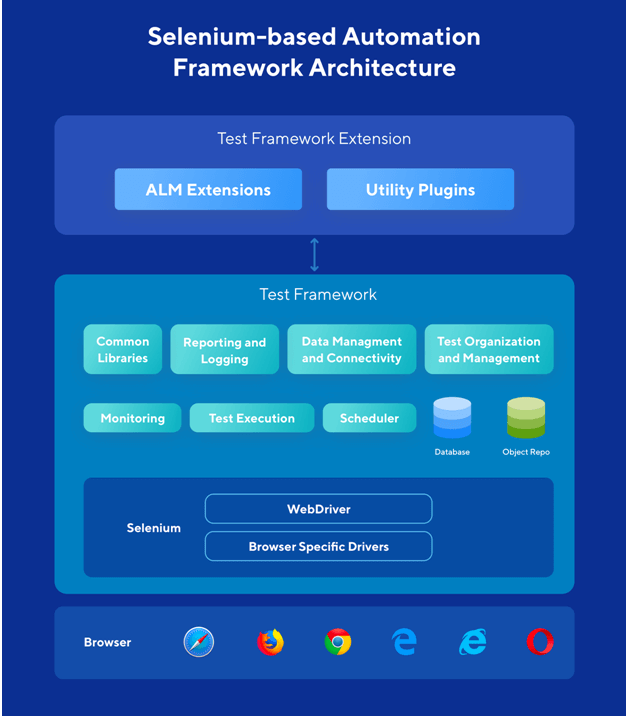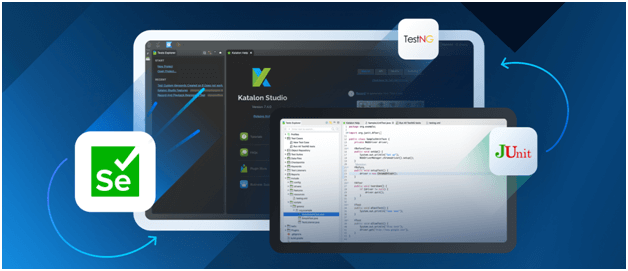In Software Test Automation market, first released as an extension, Selenium an open-source framework for Web-based application automation has emerged to become one of the leaders in the industry. Developed in 2004, the tool rose in popularity when it was made free and open-sourced, which led to the development of Selenium 2.0, or Selenium WebDriver.
For web application testing, Selenium supports all major browsers: Chrome, Safari, Firefox, etc. The main components of Selenium include:
- Selenium WebDriver: the core automation component that executes tests in different browsers by communicating through a middle-man driver. This driver is specific to the browser and runs on the same system as the browser. Furthermore, Selenium WebDriver gives you the flexibility of using any programming language of your choice to create test scripts. The only downfall is the adaptability to new systems since WebDriver runs on OS level.
- Selenium IDE: a recording and playback extension for Chrome and Firefox. Easy to set up yet with rich features such as setting breakpoints and pausing on exception, Selenium makes it easy for users to record tests cross-platform and perform test debugging. It also allows the reuse of test cases and plugins, which significantly enhances the flexibility for users.
- Selenium Grid: a tool for simultaneous testing on multiple browsers, machines, and operating systems. It consists of a hub, where all the tests are sent to. Then the hub dispatched tests to nodes, where the browsers “live” to carry out tests. Such architecture allows us to centralize the control of different browser versions and configuration, instead of individual tests.
Just like any product, Selenium does have some shortcomings. However, thanks to its rapid capability updates and strongly-supported community base, Selenium continues to be a trusted source for the testing community and a contributor to future developments in the industry.
Introduction to Selenium WebDriver

There are three main components to Selenium WebDriver: WebDriver, Browser Specific Drivers (Drivers), and Browser.
The WebDriver contains language libraries, which allows for the variety in programming languages Selenium can process (Java, Python, C#, Ruby,…). Anyone can extend this library by implementing a client library for a new language.
The commands from WebDrivers will then be transferred to the Browser Specific Drivers (Drivers), the browsers’ control center. These are browser-specific and run in the same system as the browsers. Some examples are ChromeDrivers (Google Chrome) and GeckoDrive (Firefox). Drivers will then move the requests to Browsers, where interactions on the application under test (AUT) are generated.
The communication between these components is through HTTP requests and RESTful Services responses. WebDrivers can run in a separate system from the Drivers and Browsers components, and communicate with them through the Selenium Server or Remote Web Drivers.
Advantages of Selenium
There are many advantages to testing with Selenium. The most noticeable one is the simplicity and robustness it offers for users to automate tests. There’s no third-party in between components but rather the harmony of distinct responsibilities in writing and executing tests.
Secondly, Selenium has a loosely coupled and open architecture, allowing independence between components. This flexibility makes Selenium a platform- and language-neutral testing tool, giving users the freedom of choice for programming language when testing, and increasing test coverage on multiple platforms.
Lastly, it supports integrations and extensions with other test automation frameworks to enable Agile, DevOps, or CI/CD workflow according to each team’s needs.
Disadvantages of Selenium
However, Selenium also has its drawbacks, most notable of which is the extensive expertise required of users. Due to the lack of many components for a comprehensive Software Test Automation project, such as reporting and logging, teams have to possess considerable knowledge and experiences to build, customize, and maintain a Selenium-based tool for their projects. Therefore, for non-professional users, it is highly challenging to efficiently leverage testing with Selenium as the main framework.
The steep learning curve also proves to be challenging as there is no official support from the Selenium team, which is an obstacle for those with little experience. Furthermore, the lack of a mechanism for separating scripts from data results in high maintenance costs and low reusability. There is also a lack of capability to manage and organize test assets such as test scripts, data, and test objects.
Introduction to Selenium-based Test Frameworks

Since the birth of Selenium, many software were developed to address Selenium’s limitations while utilizing its framework’s advantages. The core components of these frameworks consist of Common Libraries, Report and Logging, Data Management and Connectivity, Test Organization and Management, Monitoring, Test Execution, and Scheduler. Data is stored in databases, files, or internal data structures separately from test scripts. An open test framework also allows Application Lifecycle Management (ALM) extensions for integrating test activities and assets into the whole ALM process.
Many existing automation tools implement this Selenium-based framework like Katalon Studio or CrossBrowserTesting. Some applications even go further by integrating Appium as an engine for Software Test Automation of mobile apps to support both web and mobile automation in a single tool.
This framework does not come without challenges. One of which involves sacrificing the flexibility of choosing a preferred language as Selenium offers. A tool implementing this framework may not support as many languages as Selenium. Hence, testers have to learn the language supported by the tools.
Another challenge is the cost of migrating test scripts, data, and other test assets from one tool to another. The mismatch in organizing test assets between tools makes it difficult for migration. Fortunately, this migration concern is addressed in many comprehensive tools.
Going codeless with Katalon

Katalon Studio is the perfect Selenium alternative for users. On the one hand, it offers all the power of a Selenium framework, including extensive coverage of tests and browsers. Katalon is also compatible with all testing environments – Web, mobile, API, and desktop testing.
On the other hand, it eliminates the expertise challenge presented by Selenium through the use of built-in scripting mode, templates, and keywords libraries. Furthermore, Katalon also offers the ability to migrate test scripts from Selenium to Katalon, creating maximum flexibility for testers.
Certainly, the nature of testing differs between Selenium and Katalon Studio, yet each tool caters to different needs and testing goals in different teams. With the testing preference leaning toward DevTestOps and Agile, the need for a codeless and expertise-neutral tool would be ideal to adapt with the fast-and-accurate testing requirement.
Conclusion
Despite some minor disadvantages from the design, Selenium remains a dominant contributor to the development of the automation testing industry. Simple, robust, flexible, and open-sourced are the key characteristics that ensure its success over time.
On the other hand, codeless testing tools based on Selenium are the new generation of Software Test Automation tools that effectively curve the flaws of Selenium with most of the advantageous packages still intact. Furthermore, Katalon’s latest test migration feature offers a glimpse into the possible future to a simplified testing solution with maximum value for all teams and businesses.
- Learn JUnit annotations used for your Selenium WebDriver automation
- How to use JUnit Annotations in Selenium WebDriver Automation Script
- Automation Testing Vs Manual Testing
- JUnit and Hybrid (Keyword+Data Driven) Framework – Part 1
- What is Selenium Webdriver? – Selenium Training Series
- Installation of TestNG in Eclipse – Selenium WebDriver Tutorial
- Test Coverage in Software Testing
- Start Design Your JUnit and Data Driven Framework in Selenium
- Volume Testing In Software Testing
- Codeless Test Automation – Going Beyond with Migrating Selenium Tests to Katalon Studio
